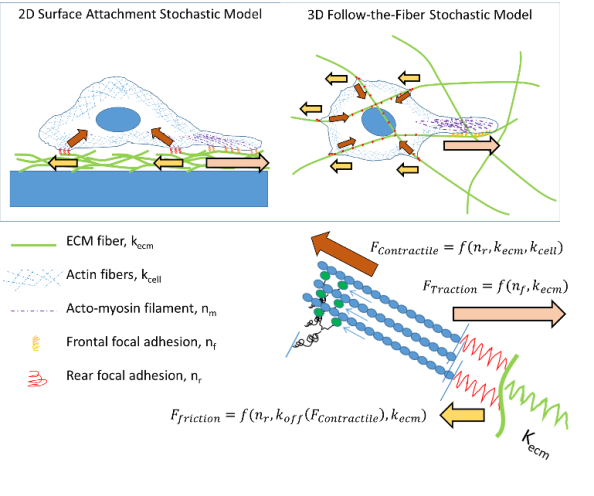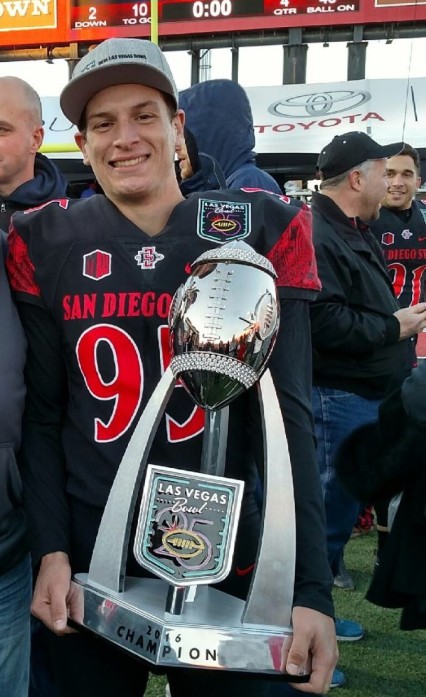Dr. Naseradinmousavi’s experiment-analysis of time-delay control of a high-DOF robot was featured in the ASME Dynamic Systems and Control Division Winter 2018 Newsletter. The analysis and experiment were carried out in the Dynamic Systems and Control Laboratory (DSCL). Please view the ASME_DSCD Winter 2018 Newsletter to read the full article. The article is titled “Analytical and Experimental Predictor-Based Time Delay Control of a High-DOF Robot Manipulator, pp: 7-9.”
Fall 2018 Senior Design Day
Our Fall 2018 Senior Design Day was held on December 11, 2018 in Montezuma Hall at the Aztec Student Union. ME Capstone Design teams showcased their projects that they have been working on for a full academic year, to fellow students, faculty and staff. Check out the photos of the teams and projects below!
Dr. Katira receives $192,000 in funding from the NSF to study how cancer cells migrate across stiffness barriers in tissues and metastasize
The grant is part of a $592,000 collaborative research project between SDSU and UCSD which aims on understanding the interactions between aggressive cancer cells and the surrounding tissue matrix using mathematical modeling and experimental research. Normal cells in lab experiments show a preference for migrating towards stiffer tissue environments, a process called durotaxis. However, during cancer metastasis, cancerous cells break off from the parent tumor, migrate away from stiff tissue environments and into softer surrounding tissues. The project will try and explain this paradox by analyzing the migration and durotactic behavior of cancer cells based on the differences in their mechanical properties and their ability to sense stiffness changes in the tissue environment. In addition, the grant aims to train undergraduate and graduate students at both schools in complementary computational and experimental cell mechanics techniques.

Pictured above: A schematic of force generation, sensing and migration machinery inside cells
Mechanical Engineering Senior Balances Academics and Athletics

Garrett Erickson is a Mechanical Engineering Senior who will be graduating in Spring 2019. Garrett has been on the SDSU Aztecs Football team since his freshman year in 2015 as the backup kicker. He has been working in Dr. Camacho’s lab to obtain experience and put what he has learned in his ME courses to use. After he graduates, he plans to work on designing cars since he has been interested in cars since he was young. Garrett states that it has gotten easier every semester for him to balance football and academics because of his time management skills, “I always plan out when I am going to do homework or projects because of the little amount of time I get. I do not procrastinate but I do give myself extra time to do things in case I get side tracked.”
Mechanical Engineering Junior Excels in Academics and Athletics

Anna Stahlak is currently a Junior at SDSU, after transferring from San Diego Mesa Community College. Her story of how she has excelled in athletics and academics is told in her words below:
My academic and athletic story has been a journey to get to where I am today at San Diego State University. I always knew I wanted to be an engineer once I got to college, but I also had been an athlete my whole life and I did not want that to stop when moving to the next level of my education. My freshman year (2015-16), my athletic career took priority when I chose to attend CSU-Bakersfield, a Division I university, in order to have an opportunity to continue my swimming career which had started when I was 5 years old. At Bakersfield, I was an engineering major, loading my schedule with calculus, physics, and, of course, engineering classes, but I began to realize that I wanted to transfer back home and attend the school I always wanted to, San Diego State University. I knew that this was going to be a difficult task not only academically, having to keep my grades up, but also because I wanted to continue to swim. After putting a lot of thought into it, I knew I was up for the challenge of transferring. I ended up leaving Bakersfield with a 4.00 GPA, which truly amazed me, proving to myself that I could achieve anything and motivated me even more to take this challenge head on. I then transferred to a local community college, San Diego Mesa Community College, my sophomore year (2016-17) in order give me a better opportunity to transfer to SDSU. I knew that transferring classes over would be easier from a local community college but it was still a huge risk for me to transfer back home because I truly had no idea what my future would hold. I also continued my swimming career, competing with Mesa half the year and then training with my club and by myself the other half. I still was determined to continue swimming if I was able to transfer; I was not ready for that aspect of my life to end. My sophomore year was packed with a full-time school schedule, 19 units each semester, and training full-time, and though it was tough, I needed to do this in order to reach both of my goals. Finally, the determining day came of whether I was going to be able to transfer to SDSU, and not only that, but swim there too and I did it! All my hard work had paid off, getting accepted into SDSU Fall 2017 as a Mechanical Engineering major with a 3.95 GPA, and on top of that I was given the opportunity to continue my swim career as a Division I athlete again. I still to this day, around a year later, as I am walking through campus think to myself “Wow! I am here at SDSU, all the risks that I took and the hard work put in was all worth it”. With that said, my hard work has not ceased, I continue to strive for all A’s in my academics, which thus far I have achieved, and continue to train harder then I ever have. Swimming at SDSU has definitely been a challenge, training the NCAA maximum of 20 hours a week, 6 days a week, as well as doing around 6 hours extra of prehabs and rehabs to ensure my body can recover and stay strong, but I would not change it for the world. I love what I do. Every day, studying and working hard to be the best mechanical engineer as I can, as well as training hard to have the most successful swimming career as I can. As the end of this school year approaches in Spring 2018, so does the end of my 16-year swimming career and 4-year college athletic career. Though it has not been easy, a lot of late nights studying and long days trying to stay awake in class with a coffee in hand after 6 am practices (not going to lie), it was all so worth it. And when the day comes that I have a mechanical engineering degree in hand from San Diego State University in Spring 2020, after studying this subject for 5 years, I will have proven to myself and everyone around me that anything is possible if you put your mind to it.
Experimental Mechanics Laboratory (Dr. Youssef’s lab) receives support from the DoD to advance mechanics of impact mitigating polymers
Through the recent award by the Department of Defense, we seek to uncover the deformation mechanisms of impact mitigating polymers by developing a novel experimental mechanics setup. Generally, in the area of materials characterization, postmortem inspections of the fracture surfaces are used to unveil the behavior of materials prior to failure. This, in turn, limits our understanding of the dynamic response of polymers due to ultrahigh strain loadings. The undertaken research will leverage the ability of terahertz waves to propagate into polymeric materials to establish an in-situ characterization technique that observes the conformational changes during any static or dynamic loading scenarios. Students from diverse backgrounds will be trained on advanced topics of experimental mechanics, mechanics of impact mitigating polymers, and the design of advanced armors.
SDSU NSF ERC Center for NeuroTechnology awarded $311,372 for fiscal year 2018-2019
The SDSU NSF ERC Center for NeuroTechnology (formerly known as CSNE) was awarded an additional $311,372 for the fiscal year of 2018-2019. This brings the total amount of award in the last 3 years alone to more than $1.4 million. Dr. Kassegne is the Deputy Director of NSF-ERC-CNT where some of the key projects funded at SDSU for this year include glassy carbon based spinal cord electrical stimulation probe to enable neuroplasticity and FPGA for artificial neural networks. Dr. Kee Moon was the founding Deputy Director.
Dr. Camacho receives $80,000 grant from NSF
Prof. Camacho was awarded a grant from the National Science Foundation for $80,000. The project is entitled, ” EAGER: Flame-Assisted Chemical Vapor Deposition for Energy Storage Electrode Fabrication”. The grant is to support research into innovative fabrication processes for energy storage electrodes using flame-based processes. PhD student Shruthi Dasappa (pictured) will be supported through this project.

Dr. Bhattacharjee & Dr. Camacho attend 37th International Symposium on Combustion

SDSU ME was well represented at the 37th International Symposium in Dublin, Ireland this summer. The biennial symposium provides a scientific venue for sharing ideas and experiences on the applications of combustion. Dr. Bhattacharjee and Dr. Camacho, along with their PhD students Luca Carmignani and Shruthi Dasappa, respectively, participated. Luca gave an oral presentation on Fire Science and Shruthi gave an oral presentation on Flame-based Nano-materials. The Symposium is the premier venue for top combustion research dissemination that requires acceptance in the accompanying peer-reviewed publication (Impact Factor 5.34) to be invited to orally present.
Dr. Kassegne organizes C-MEMS 2018 International Conference at SDSU

Dr. Sam Kassegne organized a successful international conference on Carbon-MEMS that was held at SDSU campus between June 1–12, 2018. The “C-MEMS 2018 International Conference” was hosted jointly by San Diego State University and CETYS in Baja California. More than 50 of the leading experts and researchers in the broad areas of carbon-based micro devices attended this conference. Participants from US, China, Japan, Denmark, India, Mexico, Algeria, and Germany presented their latest work in this growing research area.
SDSU hosted the technical events of June 10, 11, and morning of June 12, 2018 while CETYS (Centro de Enseñanza Técnica y Superio) and CEID (Center for Innovation and Design) in Mexicali, Mexico hosted the events of the afternoon of June 12, 2018.
Key papers from the proceedings of the conference are being negotiated for publication in Journal of Nature Microsystems and Nanoengineering
















